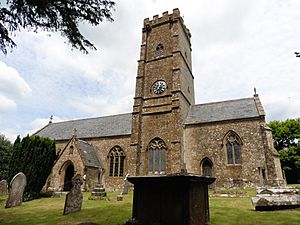Church of St Andrew, Dowlish Wake facts for kids
Quick facts for kids Church of St Andrew |
|
|---|---|
 |
|
| Location | Dowlish Wake, Somerset, England |
| Built | 14th century |
|
Listed Building – Grade II*
|
|
| Official name: Church of St Andrew | |
| Designated | 4 February 1958 |
| Reference no. | 1366405 |
| Lua error in Module:Location_map at line 420: attempt to index field 'wikibase' (a nil value). | |
The Anglican Church of St Andrew is a very old church located in Dowlish Wake, a village in Somerset, England. It was mostly built in the 14th century, which means it's over 600 years old! This church is so special that it's officially recognized as a Grade II* listed building. This means it's an important historic building that needs to be protected.
History of the Church
The Church of St Andrew has a long and interesting past. Some parts of the church, especially in the chancel (the area around the altar), are even older, dating back to the 13th century. Most of the building, including its tall tower, was constructed in the 14th century. Later, in the 15th century, some changes and updates were made.
A big renovation, called a Victorian restoration, happened in 1861 and 1862. This work was led by an architect named Benjamin Ferrey. During this time, large sections of the church were rebuilt to keep it strong and beautiful.
The church is part of a group of churches called the Winsmoor benefice. This group belongs to the Diocese of Bath and Wells, which is a larger church area.
What the Church Looks Like
The Church of St Andrew is made of stone, with special decorative parts called hamstone dressings. Its roof is covered with slate tiles. The church has a main area called the nave, which has three sections or "bays." There's also a north aisle (a side passage) and a single-bay chancel. On the north-east side, there's a two-bay chapel.
The church has a tall, three-stage tower. This tower is supported by strong corner buttresses, which are like extra supports built into the walls. Behind a battlemented parapet (a wall with gaps like a castle), there's a stair turret. Inside the tower, there's a set of eight bells that can be rung together to make music.
Inside the church, most of the furniture and decorations you see today are from the 19th century. However, there's a very old font that dates back to the 11th or 12th century! This ancient font was moved to St Andrew's in 1575 from another church in West Dowlish that was being taken down.
You'll also find several memorials inside the church. Some of these honor the Speke family. One famous member was John Hanning Speke. He was an explorer who went on three big trips to Africa. He was famous for searching for the source of the Nile River and was the first European to discover Lake Victoria.
Outside the church, in the churchyard, is a building called Speke Hall. It was built in 1840 to be a Sunday School for children. Today, it serves as the village hall, a place for community events. There's also a special memorial stone just outside the church gate.

